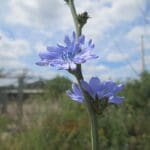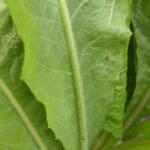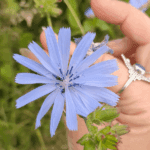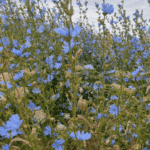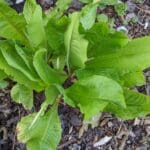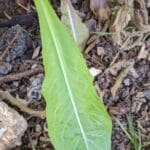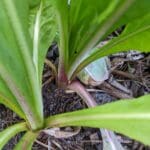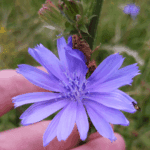Chicory / Spring / Summer / Autumn / Edible
Chicory is most commonly known for Camp coffee essence or Chicory root coffee which is used in making cakes. It has the most beautiful edible flowers.
Common Names
Chicory/Common Chicory, blue daisy, blue dandelion, blue sailors, blue weed, bunk, coffeeweed, cornflower, hendibeh, horseweed, ragged sailors, succory, wild bachelor’s buttons, swine thistle and wild endive
Botanical Name
Chichorium intybus
Scientific Classification
Kingdom – Plantae
Order – Asterales
Family – Asteraceae
Physical Characteristics of Chicory
Erect to spreading (It stands up straight but can also spread over the ground), much branched (it has lots of branches coming off the main stem), growing up to 120cm in height.
Leaves
Lower stem leaves lobed or toothed, upper stem leaves lanceolate, sessile (no stalk attaching leaf to stem), clasping the stem with pointed auricles (ear-like projection from the base of a leaf).
Stem
Stiff, grooved, glabrous (hairless) or pubescent
Flowers
Sky blue flowers 2.5-4cm across, held close to the stem. As a member of the Daisy (Asteraceae) family it has ‘ligulate’ flowers – a central disc of ‘disc flowers’ and the outer ‘ray flowers’, described as petals, though each petal is an individual flower. Flowering from July to October
Habitat
Chicory is an archaeophyte (not native but introduced in ancient times rather than recently). Believed to have been introduced as a fodder crop. Widespread in rough grassland in Southern and Central England, scattered elsewhere, rare in Scotland and Ireland.
Rough grassland, roadside verges, field margins on dry soils up to 275m.
Known Hazards
None known
Could be Confused with
When Chicory is younger it could be confused with some of the plants within the Dandelion family which are all edible.
Young leaves could potentially be confused with some of the plants within the Mustard family which are also edible but will have a mustard flavour to them.
Edible Uses
Grown as a vegetable in Roman times, it remains an important crop throughout continental Europe. The leaves and roots have quite different uses.
There are three main kinds of leaf chicory: bitter, loose-leaved cultivars grown as green winter vegetables, especially in southern Italy; narrow-leaved, Witloof or Belgian kinds, with a compact, elongate head (Chicon), which is blanched for use in salads or cooked dishes; and broad-leaved, red Chicory or radicchio types, which form cabbage-like heads, eaten raw or cooked.
Roots are harvested for coffee (especially in France) and medicinal preparations. In England, a law forbidding its use was passed in 1832 because clever merchants cheated in their production of coffee by using Chicory as an adulterant. This law was repealed in 1840, provided that the ingredient appeared on the label. Young Chicory roots give a slight biter caramel flavour when roasted; roots over two years old are much more bitter.
Leaves of Chicory found in the UK are very bitter but are improved by blanching; unblanched leaves can be used like Dandelion leaves. In Italy they are boiled and dressed with olive oil, salt and vinegar. In Iran, flowers are used to make a flower water , which is used as a skin tonic and in cooking, for example to make a sauce with tamarind and chilli.
In the 14th century Chicory was used to make a kind of confectionery to stave off thirst in hot weather.
The roasted roots have a long tradition of use either in combination with or as a substitute for coffee. The roasted roots give an earthy flavour to cakes, puddings and savoury sauces.
To obtain the flavour from roots either.
- Make an infusion with milk or water
- Roast at 120 C for 2 hours or until dry enough to grind, then chop and grind.
Fresh roots can also be used as a vegetable or to flavour rich savoury sauces.
Notes on Herbal uses
A bitter, diuretic, laxative herb that reduces inflammation and has a tonic effect on the liver and gall bladder.
Gypsies used a decoction of chicory root as a cure for jaundice.



